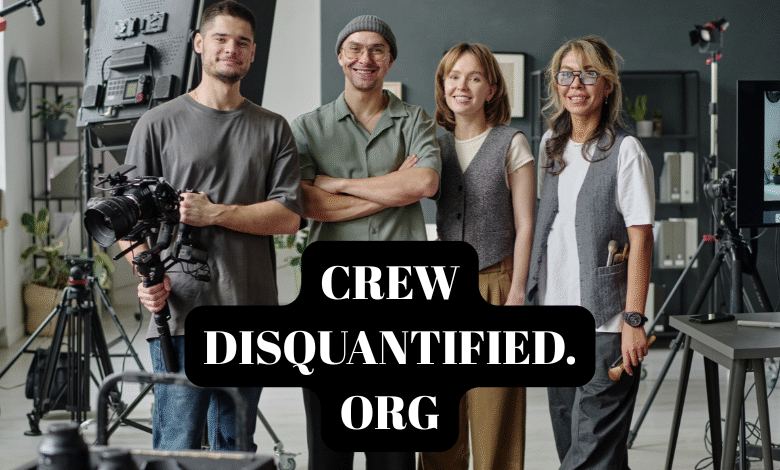Crew disquantified.org: What It Really Means and How to Thrive in the New Economy

I remember the day it clicked for me. I was sitting in a sterile, grey conference room, listening to a manager talk about “Q3 synergies” and “leveraging core competencies.” I looked around at my colleagues, all of us supposedly part of the same “corporate family.” But in that moment, I felt a profound disconnect. My future, my security, my “career,” felt entirely dependent on the whims of a system I had no real control over. The company provided the “crew,” but I was just a replaceable part within it. I felt, for lack of a better word, disquantified.
That’s a term I later encountered, and it perfectly captures the modern reality for millions of us. “Crew Disquantified.” It sounds like complex jargon, but its meaning is simple and powerful. It’s the process of being broken away from the traditional, monolithic “crew” of a single company. It’s the shift from being a permanent employee on a steady ship to being the captain of your own much smaller, more agile vessel. This isn’t just about freelancing; it’s a fundamental rewrite of the contract between individuals and their work.
For many, this idea is terrifying. It signals the end of job security, the death of the gold watch after forty years of service, and the arrival of unpredictable income. And those fears are valid. But after navigating this world for years, I’ve come to see it differently. I believe “Crew Disquantified” is not a sentence to a life of anxiety, but an invitation to a life of true freedom and ownership. This article is my attempt to walk you through what this really means, to acknowledge the real struggles, and to give you a practical, actionable map for not just surviving, but absolutely thriving in this new landscape.
What Does “Crew Disquantified” Mean? Breaking Down the Jargon.
Let’s demystify this term, because once you understand it, everything else falls into place.
Think of the word “Crew.” For generations, this meant the workforce of a large organization. You joined a company—the ship—and you were part of its crew. You had a specific role, you followed the captain’s orders, and in return, the ship provided you with a steady course, safety, and a portion of the treasure at the end of the journey (your salary and pension). Your identity was often tied to the ship itself. “I am a Ford man,” or “I work for IBM.” The crew was a quantifiable, structured entity.
Now, consider “Disquantified.” This means to be broken down from that quantifiable whole. It’s the process of being separated, deconstructed, and removed from the single, easily defined unit. You are no longer just a “software engineer at Google”; you are an independent software engineering expert who can work for Google, or for a startup, or for a non-profit, all at the same time. Your identity shifts from the company you work for to the skills you work with.
So, “Crew Disquantified” describes the massive economic and cultural shift where individuals are no longer permanent, dedicated components of one corporate crew. Instead, they are independent entities—Businesses of One—who sell their skills and time to multiple “ships” in the form of projects, contracts, and gigs.
This is the core of the modern gig economy, but for skilled professionals. It’s not just about driving for Uber; it’s about a marketing director running campaigns for three different companies, a graphic designer building brands for a dozen clients, or a project manager consulting for various firms. The single, defining “crew” has been disquantified into a dynamic, fluid network of individual contributors.
Read Alsoo: Aniföix Unlocked: The Complete 2024 Guide to the Anime Streaming Phenomenon
The Forces That Broke the Traditional Crew
This didn’t happen overnight. It’s not the result of a single villainous decision. Several powerful currents converged to create this sea change.
First, globalization and the remote work revolution. The internet dissolved physical borders. A company in New York no longer needs to only hire from the New York talent pool. They can find the perfect writer in Lisbon, the perfect developer in Warsaw, and the perfect virtual assistant in Manila. This created a global marketplace for talent, which is fantastic for finding opportunity, but also means you’re now competing with a global workforce. The pandemic acted as a giant accelerator, forcing even the most traditional companies to realize that work could happen effectively outside the office. The physical “crew” stationed in one building became an antiquated concept.
Second, the rise of technology platforms. Websites like Upwork, Fiverr, Toptal, and even LinkedIn ProFinder have created a digital harbor where all these independent vessels can dock. They provide the infrastructure—the search, the payments, the communications—that makes it easy for a Business of One to connect with a company that needs a specific task done. These platforms normalized the idea of hiring for a project, not for a position. They quantified the previously unquantifiable process of finding freelance work.
Third, and perhaps most significantly, the corporate shift towards agility and cost-cutting. For companies, hiring full-time employees is expensive. It’s not just the salary; it’s the health insurance, the payroll taxes, the office space, the equipment, the HR overhead. By moving to a project-based model, companies can control costs more precisely. They pay for a specific outcome, not for a person’s time from nine to five. This “lean” mentality means companies are building smaller core “crews” and outsourcing everything else to a fluid, on-demand workforce. It’s a smart business decision for them, but it fundamentally alters the career path for the rest of us.
These three forces created a perfect storm. The technology made it possible, the globalization made it vast, and the corporate financial logic made it inevitable. The traditional crew was disquantified not out of malice, but out of a combination of technological progress and economic efficiency.
The Dark Side: Insecurity, Burnout, and the Loneliness
Before we get to the exciting, empowering part, we must stare directly into the very real challenges of this new world. Ignoring them is a recipe for failure. I’ve faced all of these, and you likely will too.
The most obvious monster is income instability. The steady, predictable paycheck is one of the most comforting things about traditional employment. When you’re a Business of One, that predictability vanishes. Some months, you might be overflowing with work and income. Other months, it can be eerily quiet. This “feast or famine” cycle is the number one source of anxiety for new freelancers and independent professionals. You have to learn to manage your cash flow, save for taxes, and build a financial runway for yourself, because no company is going to do it for you.
Then there is the administrative burden. You are now the CEO, the accountant, the sales team, the marketing department, and the IT support for your one-person enterprise. This means you’re not just doing the work you love; you’re also chasing invoices, figuring out your own health insurance, filing quarterly taxes, updating your website, and writing proposals. This can be incredibly draining and can take up to 20-30% of your time. It’s work that is often invisible but absolutely essential.
Another major challenge is burnout and the inability to switch off. When your home is your office and your work comes from multiple clients in different time zones, the line between “work life” and “home life” doesn’t just blur; it disappears. There’s always another email to send, another project to pitch, another skill to learn. The pressure to always be “on,” always be marketing yourself, can lead to a state of chronic stress that is far more intense than anything I experienced in a corporate job.
Finally, there is the loneliness. The office watercooler, the team lunches, the casual chats in the hallway—these things provide a social fabric that we often take for granted. When you’re working alone from your home office, that social interaction vanishes. You miss the camaraderie, the spontaneous collaboration, and even the simple sense of belonging to a group working towards a common goal. This isolation can be mentally tough and requires a conscious effort to overcome.
These are not small issues. They are the legitimate costs of this new freedom. But the key is to see them not as insurmountable barriers, but as business problems to be solved. And the solutions, while not always easy, are entirely within your grasp.
The Brilliant Upside: Freedom, Mastery, and True Ownership
Now, let’s talk about the sunlight. Because for all its challenges, the world of the disquantified professional is one of immense opportunity and personal fulfillment. This is why, despite the struggles, I would never willingly go back to being just a member of a traditional “crew.”
The most intoxicating benefit is radical freedom and autonomy. You get to choose. You choose the projects you work on. You choose the clients you work with. You choose your own hours and your own workplace. Do you want to work from a coffee shop? From a beach in Bali? Do you want to take a Wednesday afternoon off to go for a hike? You can. Your life is no longer dictated by a fixed schedule and a single manager’s priorities. You are in control. This sense of agency over your own time and destiny is, for me, the single greatest reward.
Next is the opportunity for accelerated learning and mastery. In a traditional job, you are often siloed into a specific role. As an independent professional, you are constantly exposed to new industries, new business problems, and new technologies. One month you might be building a website for a bakery, the next you’re creating a marketing strategy for a tech startup. This variety forces you to learn and adapt at a breathtaking pace. You are not just deepening one skill; you are building a wide and versatile portfolio of expertise, which in turn makes you more valuable and allows you to command higher rates.
Then there is the concept of true ownership and direct reward. In a corporate job, if you work incredibly hard and create a million dollars in value for the company, you might get a 5% bonus. The rest of the value is captured by the shareholders and the company itself. When you are a Business of One, the link between your effort and your reward is direct and unambiguous. If you do great work, you get paid well, and you get more clients through referrals. If you increase your skills, you can increase your rates. You are building your own asset—your reputation, your portfolio, your network—and you reap 100% of the benefits. You are no longer building someone else’s dream; you are building your own.
Finally, there is resilience. This might seem counterintuitive given the income instability, but think about it. If you have one job, you have one point of failure. If you get laid off, your entire income goes to zero. But if you have five clients, and you lose one, you still have 80% of your income. You have a diversified client base, which is a much more robust and secure position to be in than relying on a single employer. You have spread your risk.
The disquantified life is not a easier life. It is a harder one in many ways. But it is a better one. It is a life of challenge, growth, and self-determination. The security you lose in a steady paycheck, you gain in control over your own destiny.
Your Action Plan: How to Build Your Lifeboat and Set Sail
Understanding the theory is one thing. Taking action is another. If you’re feeling inspired but also a little daunted, this five-step plan is your blueprint. This is the practical guide I wish I had when I started.
Step 1: Audit Your Skills and Define Your Offer
You cannot sell something you haven’t defined. Start by taking a complete inventory of your skills. Don’t just list your job title. Break it down.
-
What are your core, money-making skills? (e.g., writing code in Python, designing logos, writing SEO articles, managing social media campaigns).
-
What are your secondary, supportive skills? (e.g., project management, client communication, teaching, public speaking).
-
What do people consistently ask you for help with? This is a great indicator of a valuable skill.
Now, get specific. “I’m a designer” is too vague. “I am a graphic designer who specializes in creating bold, minimalist brand identities for sustainable consumer brands” is a specific offer. This is called a niche, and it’s incredibly powerful. It makes you the obvious choice for a specific type of client, rather than a generic option for everyone. Your niche can be based on industry, type of service, or type of client.
Step 2: Build Your Digital Home Base
You need a place online that you own and control. This is your professional home. For most, this is a simple, clean website with a portfolio and an “About Me” page.
-
Your Portfolio: This is your proof. Don’t just say you’re good; show it. Include 3-5 of your best projects. For each project, write a case study: What was the problem? What did you do? What was the result? Use numbers whenever possible. “I designed a new website that increased user sign-ups by 25%.”
-
Your About Page: This is where you connect. Write in your own voice. Tell your story. Why do you do what you do? What do you believe in? People hire people, not just skills. Let them see the person behind the work.
-
Clear Contact Information: Make it stupidly easy for people to get in touch with you.
Your LinkedIn profile should be polished and point to this home base. Your website is your headquarters; social media are your outposts.
Step 3: Create Content, Don’t Just Consume It
This is the single most powerful marketing strategy for a Business of One. Share your knowledge freely. This does two things: it establishes you as an expert, and it builds trust.
-
Write Articles: Post on your own blog or on platforms like Medium. Answer common questions your clients have.
-
Create Videos: Make short, helpful videos for LinkedIn or YouTube.
-
Post on Social Media: Share insights, comment on industry trends, and show glimpses of your work process.
When you create content, you are not begging for work. You are attracting it. You are demonstrating your expertise so that when someone has a problem you can solve, you are the first person who comes to mind. I’ve landed some of my best clients because they read an article I wrote and reached out to me directly.
Step 4: Learn the Business of Business
This is the unsexy but critical part. You are a business now, so you need to think like a CEO.
-
Finances: Open a separate business bank account. Track every dollar that comes in and goes out. Use an accounting tool. Set aside 25-30% of every payment for taxes. Pay yourself a regular “salary” from your business account to your personal account to smooth out the income instability.
-
Contracts: Never, ever start work without a signed contract. It protects both you and the client. You can find good templates online from legal services. It should outline the scope of work, payment terms, deadlines, and what happens if things go wrong.
-
Negotiation: You must get comfortable talking about money. Your rate is not just a number; it’s the value you provide. Practice saying your rate with confidence. Remember, you are not an expense; you are an investment.
Step 5: Build a Network, Not a List of Contacts
Your network is your net worth in this new economy. But networking isn’t about collecting business cards. It’s about building genuine, reciprocal relationships.
-
Help Others: The best way to build a strong network is to be helpful. Introduce two people who should know each other. Share someone else’s work. Give feedback freely.
-
Stay in Touch: Don’t just reach out to people when you need something. Send a congratulatory note when you see they’ve achieved something. Share an article you think they’d find interesting.
-
Find Your Community: Join online forums, Slack groups, or local meetups for people in your industry. This is the antidote to loneliness and a fantastic source of support, advice, and referrals.
This five-step plan is a cycle, not a one-time event. You will constantly be refining your offer, updating your portfolio, creating new content, managing your business, and nurturing your network. This is the work of building a sustainable, fulfilling career in the age of the disquantified crew.
Conclusion
The era of the single, defining “crew” is over. The safety it promised was often an illusion, a comfortable cage that limited our potential and outsourced our agency. The concept of “Crew Disquantified” can initially feel like a loss, a fracturing of the old world. But I urge you to see it for what it truly is: a liberation.
It is the opportunity to stop being a passive passenger on a large, slow-moving ship and to become the captain, navigator, and crew of your own destiny. The waters may be rougher, and the responsibility is entirely on your shoulders, but the horizon is limitless. You get to chart your own course, based on your own skills, values, and definition of success.
The path is not easy. It demands courage, discipline, and a relentless commitment to learning. But the reward—a career built on freedom, mastery, and true ownership—is worth every challenge. You are no longer just a member of a crew. You are the enterprise. Embrace it.
Frequently Asked Questions (FAQ)
Q1: Is “Crew Disquantified” just a fancy term for being a freelancer?
A: It’s related, but it’s broader. Freelancing is a type of work. “Crew Disquantified” describes the overarching economic and cultural shift that makes freelancing and project-based work the new normal for skilled professionals. It’s the “why” behind the rise of the freelance economy.
Q2: I have a stable job I like. Should I still be worried about this trend?
A: “Worried” is the wrong word. “Aware” is better. Even within stable jobs, the skills required are changing rapidly. Adopting the mindset of a Business of One—continuously learning, building your personal brand, and maintaining your network—will make you more valuable to your current employer and infinitely more secure in your career, no matter what the future holds.
Q3: How do I deal with the lack of health insurance and retirement benefits?
A: This is a major practical concern. In many countries, you can purchase health insurance through national marketplaces. For retirement, you can set up your own tax-advantaged accounts. It requires more proactive management, but it is entirely possible and often gives you more control and choice over your plans.
Q4: I’m just starting out. How do I know what to charge?
A: This is the million-dollar question. Research what others in your niche and experience level are charging. Start by calculating your desired annual salary, adding about 30% for taxes and business expenses, and then dividing that by the number of billable hours you think you can work in a year. Don’t undervalue yourself. It’s easier to start with a slightly higher rate and negotiate down than to raise your rates with existing clients.
Q5: How long does it take to build a sustainable independent career?
A: There’s no one answer, but expect it to take 6 to 18 months of consistent effort to build a steady stream of clients and a reliable income. The first year is often the toughest. Focus on delivering exceptional work for your first few clients, as their testimonials and referrals will be the rocket fuel for your business.



